Nick Faulks (1909) - Spanton (1976)
English/QGD Tarrasch
1.c4 e6 2.Nc3 d5 3.e3!? Nf6 4.Nf3 c5 5.cxd5 exd5 6.d4
*****
*****
*****
*****
6...Nc6
This was a mainline position long before Siegbert Tarrasch was born - there are 4,556 examples of the position in ChessBase's 2023 Mega database.
7.Be2 Be6
This has been played by grandmasters, but is very much a sideline compared with the likes of 7...Be7, 7...cxd4, 7...Bd6 and 7...a6.
8.0-0 Ne4!?
The aim of this move is to make it awkward for White to complete his natural plan of development with b3 and Bb2 (or Ba3).
*****
*****
*****
*****
9.Nxe4?!
The text removes any advantage White has and may even leave Black a tad better. Possibly best is 9.Qc2, when Vincent McCambridge (2517) - Michael A Brooks (-), US Open (Chicago) 1979, continued 9...Nxc3 10.bxc3 Bd6 11.Rb1 Rb8 12.Ba3 with a slight edge for White, according to Stockfish15 and Komodo13.02 (1-0, 26 moves).
9...dxe4 10.Nd2 Bd5
Arguably more ambitious is 10...f5, while the engines give 10...cxd4 11.Nxe4 Be7 12.exd4 Qxd4 13.Ng5 Bf5!? with what they reckon is an equal position.
11.Nb3 cxd4
Not 11...Bxb3?! 12.Qxb3 cxd4? 13.Qxb7 Rc8 14.exd4 Rc7 15.Qa6, when White is winning, according to the engines.
12.Nxd4 Nxd4 13.Qxd4 Bc6 14.Rd1
White has more chance of an edge after 14.Qc3.
14...Qxd4 15.Rxd4 Rd8!? 16.Rxd8+ Kxd8 17.b3 Bd6 18.Bb2 f6 19.Rd1 ½–½
Pimlico 3 won the match 3-2.


No comments:
Post a Comment